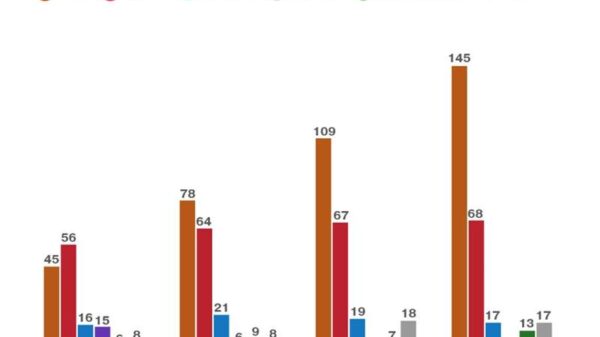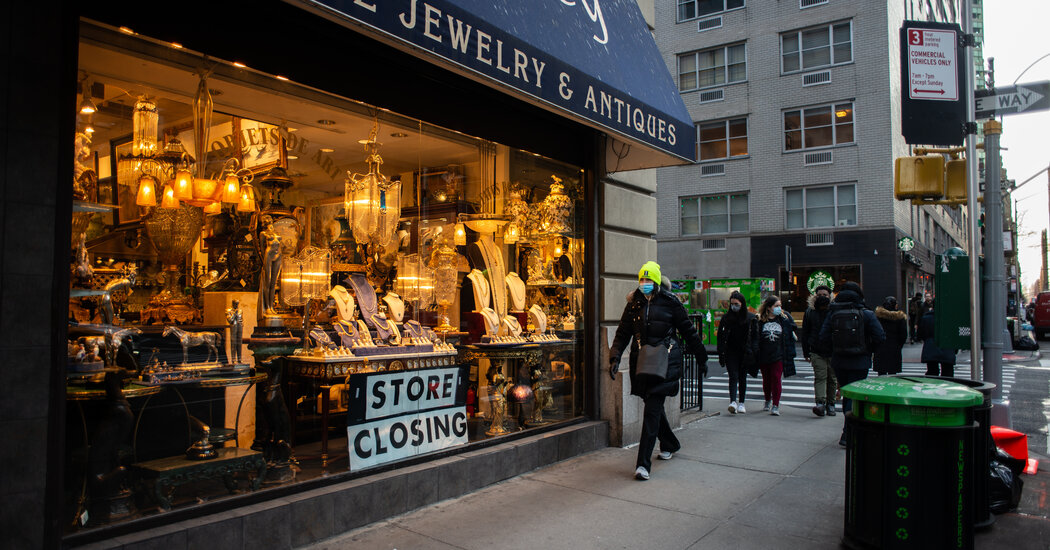The economic disruptions of the latest Covid wave have hurt blue-collar workers the most, even as Wall Street profits, rents and home sales are soaring.
As the pandemic stretches into a third year, the Omicron variant has added another speed bump in New York City’s road back to normalcy, injecting fresh uncertainty into the economic outlook and threatening to worsen the city’s already lopsided recovery.
Office workers were sent home again, reversing steady increases in subway ridership and hurting small businesses in central business districts. A survey of major companies by the Partnership for New York City, a business advocacy group, found that 75 percent of employers have delayed their return-to-office plans.
The last two months were supposed to be uplifting, with the arrival of overseas travelers offering a glimmer of hope for the hundreds of thousands of workers whose jobs rely on tourists.
Instead, hotel occupancy rates plummeted. Temporary closure signs filled restaurant windows, bank branches and public libraries hobbled by sick employees. Broadway shows abruptly shut down, some permanently.
Now the Omicron surge is subsiding, with the average number of recorded daily cases down more than 80 percent from their peak in early January. But its effects are still lingering, especially for blue-collar workers.
Like other waves of the coronavirus, this one has disproportionately inflicted pain on employees who must show up in person, deepening the stark economic divide that has defined New York City’s fragile jobs recovery, the slowest of any large American city.
In December, service-sector employees in the New York City area worked an average of 22.9 hours per week, lower than in December 2020, when the average was 25.4 hours, according to data compiled by Gusto, a payroll platform. Working hours dropped even more the first two weeks of January, despite a sharp decline in new virus cases.
“It’s clear Omicron is doing some meaningful damage here,” said Mark Zandi, chief economist at Moody’s Analytics. “New York City is going to bounce back, but it’s not going to bounce all the way back for a long time.”
Still, parts of the city’s economy are booming. Wall Street firms like JPMorgan Chase, the city’s largest private employer, reported blockbuster profits in 2021, with significant pay increases for bankers. This helped drive overall personal income in New York to higher levels than in 2019, putting city and state finances in a healthier position than economists had expected.
In a report published this month, the city’s Independent Budget Office described a “remarkably stable” fiscal outlook for New York, based on conditions in late November. Billions of dollars in federal pandemic aid, including stimulus checks and expanded unemployment benefits, had helped replenish the city’s lost tax revenues.
But given the uncertain impact of the Omicron variant, budget office economists now caution that their outlook was potentially too optimistic. (And the stock market has also started the year on a wild and volatile ride, with the S&P 500 Index down more than 9 percent this month, after gaining 26.9 percent in 2021.)
The latest virus wave has been enormously disruptive for small businesses like Land to Sea, a cafe and event space that opened in Brooklyn’s Williamsburg neighborhood in October.
On Dec. 16, the cafe kicked customers out in the middle of the day because an employee had been exposed to the virus. It took so long for the rest of the staff to receive test results that the cafe closed for two days, then switched to takeout only for 17 days. (Everyone ended up testing negative.)
When an employee did test positive this month, Emily Shum and Eva Zhou, the co-owners, struggled with confusing and shifting federal guidance around isolation periods. They decided to require the employee to show a negative test before coming back. “We’re still being really cautious,” Ms. Shum said.
A particularly troubling economic indicator is the city’s labor market, which has consistently lagged the recovery nationwide. New York City had an 8.8 percent unemployment rate in December, according to a jobs report released last week, compared with 3.9 percent nationally.
New York City is not expected to recoup all the jobs it lost during the pandemic until late 2025, the budget office projected, while the national economy is projected to surpass prepandemic employment this year.
Compared with other large cities, a disproportionate share of New York City’s work force is composed of low-wage jobs that rely on tourism and full office buildings.
“The risk is to have a more permanently polarized society between the haves and have-nots,” said James Parrott, an economist with the Center for New York City Affairs. “We already had a chasm between them before, but the longer this goes on, the wider that becomes. It has serious implications for the quality of life in New York City.”
The chasm could get bigger with the recent rebound in the residential real estate market, which has heightened concerns about the city’s affordability.
While rental prices dipped during the early months of the pandemic, according to the listings site StreetEasy, they have now surpassed prepandemic levels in neighborhoods like the Financial District in Manhattan and Downtown Brooklyn, where many white-collar employees have been working remotely. The median rent in SoHo, where rents increased the most last year, is now $6,002.
In the second half of 2021, more apartments sold in Manhattan than at any time in the last three decades, driven by demand for luxury buildings, according to the brokerage firm Douglas Elliman. In Brooklyn, the average sales price is almost $1.2 million, a 21 percent increase from before the pandemic.
“Rents rising means people are moving back to the city, more tax revenue, more jobs,” said Nancy Wu, chief economist at StreetEasy. But, she added, “It’s going to make it even harder for a renter to find an affordable place.”
The Omicron surge has only added to the financial uncertainty for workers like Erik Owusu, who was sent home early in the pandemic from his job setting up banquets at the Crowne Plaza Times Square hotel.
Last month, he became an Uber driver, despite fears about contracting the virus. He is hoping enough tourists will return by spring for the Crowne Plaza to reopen and call him back.
“This pandemic really messed up everybody’s plans,” Mr. Owusu said.
In mid-December, 74 percent of the city’s available hotel rooms were filled. But that plunged to about 40 percent in the second week of January, according to STR, an industry research firm.
Foot traffic at the three major airports that serve New York City also reversed their gains. In November, the airports handled more than nine million passengers, a decline of about 15 percent from prepandemic levels.
The Coronavirus Pandemic: Key Things to Know
Omicron in retreat. Though the U.S. is still facing overwhelmed hospitals and more than 2,400 deaths a day, new cases are declining in several parts of the country. But experts warned that spotty immunity and the threat of new variants mean the virus is not likely to ever completely disappear.
But in the first week of January, the number of passengers was down about 34 percent from the same week in 2019, according to the Port Authority of New York and New Jersey.
Even if international tourists return in large numbers, economists predict a permanent decline in business travel.
Gabriele Marinello, who is based in London and operates a platform that publishes scientific research, flew to New York as soon as travel restrictions were lifted in November, hoping to meet in person with funders and potential clients. He traveled with three of his employees and booked a three-month stay at an Airbnb in Brooklyn.
But as Omicron tore through the city, most of his meetings turned into Zoom calls.
“I do value in-person meetings,” Mr. Marinello said. “It’s a bit unfortunate that these are the times we are living in.”
In his first days in office, Mayor Eric Adams has repeatedly urged companies to call their employees back to the office, suggesting that companies should start with three days a week and slowly increase to five.
“It’s time to get back to work,” Mr. Adams told CNBC in an interview this month.
In mid-January, 22 percent of New York City area employees went into their offices, according to Kastle Systems, a security firm that tracks access-card swipes in office buildings — down from last year’s peak of 37 percent in early December.
Even financial firms like Goldman Sachs, which had been among the most aggressive in returning to the office, said during the Omicron wave that employees could work from home until February.
Safety concerns have added to employees’ hesitation to return to the office, business leaders say. After a spate of violent attacks this month, including the death of a woman who was shoved into an oncoming subway train in Times Square, Mr. Adams unveiled an ambitious public safety plan, including calling for changes to the state’s bail laws.
The future of office buildings, the largest contributors to the city’s property tax base, is especially uncertain. Although office leasing activity increased in the last months of 2021, vacancy rates have continued to climb, ending the year at 20.4 percent, nearly double the rate before the pandemic, according to Cushman & Wakefield, a real estate firm.
In the area around Grand Central Terminal, 30 percent of the ground-floor retail spaces are either vacant or still closed, according to the Grand Central Partnership, a group that promotes the area’s businesses.
Just a few months ago, San Cheng thought his all-you-can-eat seafood restaurant, Crab House in Midtown Manhattan, had finally moved past the worst days of the pandemic.
The surge from the Delta variant had faded, and daily cases had dropped to some of the lowest levels of the pandemic. Office workers were filling up Midtown again, and overseas visitors were expected to start returning.
With that optimism, Mr. Cheng decided in late September to expand Crab House, building an outdoor dining area primarily to accommodate diners who were not vaccinated and prohibited from eating indoors. But the structure was only used a handful of times before cold weather and the Omicron variant scared away diners.
Even now, more than 60 percent of reservations at Crab House are being canceled on an average day, Mr. Cheng said.
Through it all, he remains hopeful that his business will endure.
“We’re still feeling good about our future,” he said. “Otherwise, we won’t make it, you know?”
Lananh Nguyen contributed reporting.





























